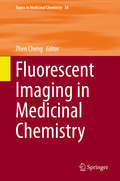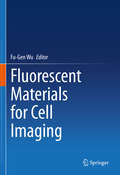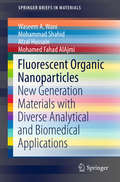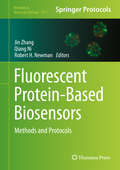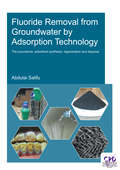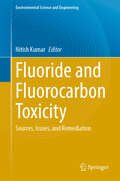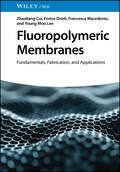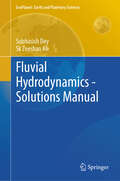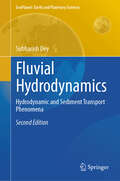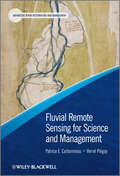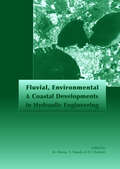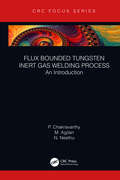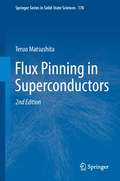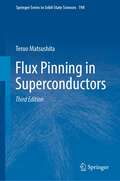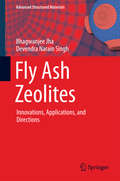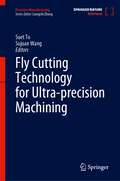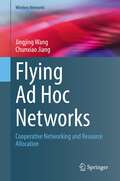- Table View
- List View
Fluorescent Imaging in Medicinal Chemistry (Topics in Medicinal Chemistry #34)
by Zhen ChengThis book reviews the most recent developments of fluorescent imaging techniques for medicinal chemistry research and biomedical applications, including cell imaging, in vitro diagnosis and in vivo imaging. Fluorescent imaging techniques play an important role in basic research, drug discovery and clinical translation. They have great impact to many fields including chemical biology, cell biology, medical imaging, cancer diagnosis and treatment, pharmaceutical science, among others, and they have facilitated our understanding of diseases and helped to develop many novel powerful tools for imaging and treatment of diseases. This book will appeal to scientists from numerous fields such as chemistry, pharmaceutical science, biology, materials science, and medicine, and it will serve as a very useful and handy resource for readers with different levels of scientific knowledge, ranging from entry level to professional level.
Fluorescent Materials for Cell Imaging
by Fu-Gen WuThis book focuses on the latest fluorescent materials for cell imaging. Cell imaging is a widely used basic technique that helps scientists gain a better understanding of biological functions through studies of cellular structure and dynamics. In the past decades, the development of a variety of new fluorescent materials has significantly extended the applications of cellular imaging techniques. This book presents recently developed fluorescent materials, including semiconductor quantum dots, carbon dots, silicon nanoparticles, metal nanoclusters, upconversion nanoparticles, conjugated polymers/polymer dots, aggregation-induced emission (AIE) probes, and coordination compounds, used for various cellular imaging purposes. It will appeal to cell biologists and other researchers in academia, industry and clinical settings who are interested in the technical development and advanced applications of fluorescence imaging in cells, tissues and organisms to explore the mechanisms of biological functions and diseases.
Fluorescent Microscopy (Methods in Molecular Biology #2440)
by Bryan HeitThis volume provides both experienced and new microscopists with methods and protocols to perform fluorescence microscopy-based experiments. The book is divided into four parts detailing basic fluorescent microscopy, quantitative methods, imaging living animals, human tissue samples, approaches for imaging at a near-molecular level, and approaches to image analysis. Written in the format of the highly successful Methods in Molecular Biology series, each chapter includes an introduction to the topic, lists necessary materials and reagents, includes tips on troubleshooting and known pitfalls, and step-by-step, readily reproducible protocols. Authoritative and cutting-edge, Fluorescent Microscopy aims to be a useful practical guide to researches to help further their study in this field.
Fluorescent Organic Nanoparticles: New Generation Materials with Diverse Analytical and Biomedical Applications (SpringerBriefs in Materials)
by Waseem A. Wani Mohammad Shahid Afzal Hussain Mohamed Fahad AlAjmiThis book provides a critical review of recent advances in the development of fluorescent organic nanoparticles as materials of choice for the design and fabrication of sensors, bioimaging agents and drug delivery systems. The properties and functions of nanoparticles differ significantly from those of their parent entities or their bulk phases. Two of their most important features are their increased surface-to volume ratio, and the formation of surface structures differing from those in their bulk phases. In addition, the book discusses the synthesis of fluorescent conjugated polymers, self-assembled fluorescent nanoparticles, polydopamine nanoparticles, and aggregation-induced-emission or aggregation-induced-emission enhancement nanomaterials. In closing, the book provides an outlook on future research and development in fluorescent organic nanoparticles as smart materials with an impressive range of potential applications.
Fluorescent Protein-Based Biosensors
by Jin Zhang Qiang Ni Robert H NewmanThis book features step-by-step, readily reproducible protocols used to describe several methods in which fluorescent protein-based reporters can be used to gain unique insights into the regulation of cellular signal transduction.
Fluorescent Tools for Imaging Oxidative Stress in Biology (Springer Theses)
by Amandeep KaurThis thesis advances the long-standing challenge of measuring oxidative stress and deciphering its underlying mechanisms, and also outlines the advantages and limitations of existing design strategies. It presents a range of approaches for the chemical synthesis of fluorescent probes that detect reversible changes in cellular oxidative stress. The ability to visualise cellular processes in real-time is crucial to understanding disease development and streamline treatment, and this can be achieved using fluorescent tools that can sense reversible disturbances in cellular environments during pathogenesis. The perturbations in cellular redox state are of particular current interest in medical research, since oxidative stress is implicated in the pathogenesis of a number of diseases.The book investigates different strategies used to achieve ratiometric fluorescence output of the reversible redox probes, which nullify concentration effects associated with intensity-based probes. It also describes suitable approaches to target these probes to specific cellular organelles, thereby enabling medical researchers to visualise sub-cellular oxidative stress levels, and addressing the typically poor uptake of chemical tools into biological studies. In total it reports on four new probes that are now being used by over twenty research groups around the globe, and two of which have been commercialised. The final chapters of this thesis demonstrate successful applications of the sensors in a variety of biological systems ranging from prokaryotes to mammalian cells and whole organisms. The results described clearly indicate the immense value of collaborative, cross-disciplinary research.
Fluoride Removal from Groundwater by Adsorption Technology
by Abdulai SalifuIn the Eastern corridor of Northern region of Ghana, presence of high fluoride concentration in the groundwater has made many drilled boreholes unusable for drinking. Little is, however, known about the factors contributing to the occurrence of high fluoride in this part of Ghana and it’s spatial distribution. Treatment of the fluoride-contaminated groundwater by adsorption is also hampered by the lack of suitable adsorbents that are locally available. Based on principal component analysis, and saturation indices calculations, this thesis highlights that, the predominant mechanisms controlling the fluoride enrichment probably include calcite precipitation and Na/Ca exchange processes, both of which deplete Ca from the groundwater, and promote the dissolution of fluorite. The mechanisms also include F-/OH- anion exchange processes, as well as evapotranspiration processes which concentrate the fluoride ions, hence increasing its concentration in the groundwater. Spatial mapping showed that the high fluoride groundwaters occur predominantly in the Saboba, Cheriponi and Yendi districts. The thesis further highlights that, modifying the surface of indigenous materials by an aluminium coating process, is a very promising approach to develop a suitable fluoride adsorbent. Aluminum oxide coated media reduced fluoride in water from 5. 0 ± 0.2 mg/L to ≤ 1.5 mg/L (which is the WHO health based guideline for fluoride), in both batch and continuous flow column experiments in the laboratory. Kinetic and isotherm studies, thermodynamic calculations, as well as analytical results from Fourier Transform Infrared Spectroscopy and Raman spectroscopy, suggest the mechanism of fluoride adsorption onto aluminium oxide coated media involved both physisorption and chemisorption processes. Field testing in a fluoritic community in Northern Ghana showed that the adsorbent is also capable of treating fluoride-contaminated groundwater in field conditions, suggesting it is a promising defluoridation adsorbent. The adsorbent also showed good regenerability potential that would allow re-use, which could make it practically and economically viable. Additional research is, however, required to further increase the fluoride adsorption capacity of developed adsorbent.
Fluoride and Fluorocarbon Toxicity: Sources, Issues, and Remediation (Environmental Science and Engineering)
by Nitish KumarThis book presents fluoride and fluorocarbon toxicity with respect to remediation and health issues. It covers sources of fluoride and fluorocarbon contamination, its impact on human health, and prospective remediation by multi-disciplinary approaches with the application of recent advanced technology. This book brings together a diverse group of researchers from different disciplines to address the challenges posed by global mass poisoning caused by fluoride and fluorocarbon contamination. The book sheds light on the global environmental issues and proposes solutions to contamination through multi-disciplinary approaches. The book contains three parts. The first part describes the different sources and distribution of fluoride and fluorocarbon in soil and water. The second part explains the health risks linked to fluoride and fluorocarbon toxicity. The third part addresses sustainable fluoride and fluorocarbon toxicity mitigation strategies and the potential applications of recent biotechnology in providing solutions. This book is a valuable resource to students, academics, researchers, and environmental professionals working in the field of fluoride and fluorocarbon contamination.
Fluorides in Drinking Water: Source, Issue, and Mitigation Strategies (Environmental Science and Engineering)
by Kartika SharmaThis book brings together a diverse group of researchers to address the challenges posed by global mass poisoning caused by fluoride contamination of water bodies. The book sheds light on this global environmental issue and proposes solutions to contamination through multi-disciplinary approaches. Water is considered a vital resource because it is necessary for all aspects of human and ecosystem survival. However, due to natural processes and anthropogenic activities, various pollutants have been added to the water system. Among these, fluoride and fluorocarbons (fluorinated carbon) are some of the most serious pollutants. It occurs naturally in several minerals and in trace quantities in water. Due to its characteristics, it is very widely used in medicine, dentistry, industry, or agriculture. Fluoride content in drinking water is very important from health point of view as because it has long been recognized as a constituents of bones, teeth, soft tissues, and body fluids. On the other hand, its universality possesses a real threat to the human body in the form of acute and chronic poisoning. There are reports that excessive fluoride intake for extended period causes adverse effects of health such as fluorosis, cancer, arthritis, and other diseases. It has also been observed that fluoride in excess affects human intelligence, especially in children, who are most susceptible to early fluoride toxicity. This book contains three sections. The first section describes the different sources and distribution of fluoride in water ecosystem. The second section explains the health risks linked to fluoride poisoning. The third section addresses sustainable fluoride toxicity mitigation strategies and the potential applications of recent biological technology in providing solutions. This book is a valuable resource to students, academics, researchers, and environmental professionals doing fieldwork on fluoride and fluorocarbons contamination throughout the world.
Fluoropolymeric Membranes: Fundamentals, Fabrication, and Applications
by Enrico Drioli Young Moo Lee Zhaoliang Cui Francesca MacedonioEnables readers to gain a comprehensive understanding of fluoropolymeric membrane science and technology from a single resource Fluoropolymeric Membranes: Fundamentals, Fabrication, and Applications comprehensively and systematically covers the basic science and technology of fluoropolymeric membranes, which have high mechanical strength and excellent chemical stability and thus have been employed for the last several decades as materials for membrane separation processes in a variety of applications. Written by four highly qualified authors, Fluoropolymeric Membranes includes information on: Typical fluoropolymers like poly(vinylidene fluoride), poly(tetrafluoroethylene), and poly(ethylene chlorotrifluoroethylene) Structure and properties of fluoropolymeric membranes, and fabrication strategies of advanced fluoropolymeric membranes Fluoropolymeric membranes novel applications in chemical- and bio-separations, hybrid systems, energy, fuel cells, batteries, gas and air treatments, and more How fluoropolymeric membranes support common water treatment processes, such as ultrafiltration, microfiltration, MBR membrane processes, and more New membrane operations such as membrane distillation, membrane crystallization, membrane emulsification, and membrane contactors Providing complete coverage on the subject, Fluoropolymeric Membranes is an essential resource for polymer chemists, membrane scientists, process engineers, materials scientists, water chemists, environmental chemists, and chemists in industry.
Flush!
by Buffy SilvermanExplore the world of plumbing when Andy and Lizzie learn how the pipes in their house work. Some pipes carry out dirty water while others carry in clean water.
Flush! (Fountas & Pinnell Classroom, Guided Reading)
by Susan BuckleyNIMAC-sourced textbook. Have You Ever Wondered where your poop goes? Find out what happens after you flush—and why it matters.
Flushed with Pride: The Story of Thomas Crapper
by Wallace RayburnFlushed with Pride celebrates the life and times of Thomas Crapper, the man who revolutionised the nation's water closets and plumber By Appointment to Edward VII. First published 20 years ago, this fascinating book achieved cult status on both sides of the Atlantic and is now reissued for the delectation of loo readers everywhere.
Fluvial Hydrodynamics - Solutions Manual (GeoPlanet: Earth and Planetary Sciences)
by Subhasish Dey Sk Zeeshan AliThe book provides the solutions to the unsolved problems given in the book titled Fluvial Hydrodynamics: Hydrodynamic and Sediment Transport Phenomena. The manual includes the solutions to the problems on Chapters 1 to 11, including the properties of fluid and sediment, hydrodynamic principles, turbulence in open-channel flows, sediment threshold, bedload transport, suspended-load transport, total-load transport, bedforms, river processes, scour, and dimensional analysis and similitude. It, therefore, serves as a guide for graduate students, researchers, and field engineers to solve the problems in fluvial hydrodynamics. As a prerequisite, the background of the readers should have a knowledge in fluvial hydrodynamics described in the said book and an understanding of fundamentals of calculus.
Fluvial Hydrodynamics: Hydrodynamic and Sediment Transport Phenomena (GeoPlanet: Earth and Planetary Sciences)
by Subhasish DeyThis revised second edition of the book presents an improvement of the original version in terms of recent research, corrections, and outline. The state of the art in fluvial hydrodynamics can be examined only through a careful exploration of the theoretical development and applied engineering technology. This second, updated edition focuses, since most up-to-date research findings in the field are presented, on the research aspects that involve a comprehensive knowledge of sediment dynamics in turbulent flows. It begins with the fundamentals of hydrodynamics and particle motion followed by turbulence characteristics related to sediment motion. Sediment dynamics are described from a classical perspective by applying the mean bed shear approach and additionally incorporating a statistical description for the role of turbulence. It is intended to design as a course textbook in graduate / research level and a guide for the field engineers as well, keeping up with modern technological developments. One of the most important additions is that at the end of each chapter, varieties of problems were given. Therefore, as a simple prerequisite, the background of the readers should have a basic knowledge in hydraulics in undergraduate level and an understanding of fundamentals of calculus.
Fluvial Processes: 2nd Edition (IAHR Monographs)
by Ana Maria da Silva M. Selim YalinA stream flowing in alluvium deforms its bed surface, forming ripples, dunes, bars, etc., and, in many instances, it deforms its channel entirely, thereby creating meandering or braiding patterns. It could be said that, in general, an alluvial stream and its deformable boundary undergo a variety of fluvial processes leading to the emergence of a multitude of alluvial forms. This book concerns the physics and analytical treatment of various fluvial processes and the associated alluvial bed and plan forms listed above. Following an introductory chapter on the basics of turbulent flow and sediment transport, the book covers the origin, geometric characteristics and effects of bed forms, from small- to meso-scale (ripples, dunes, alternate and multiple bars); the initiation, geometry and mechanics of meandering streams; the computation of flow, bed deformation and the planimetric evolution of meandering streams; and braiding and delta formation. The book also covers the regime concept, the time-development of a stream towards its regime state, and the formulation of stable, or equilibrium, morphology. The book distinguishes itself by its comprehensive analysis and discussion of key processes involved in large-scale river morphodynamics. The book was written primarily for researchers and graduate students of hydraulic engineering, water resources and related branches of earth sciences, but it will also prove useful for river engineers and managers.
Fluvial Remote Sensing for Science and Management
by Patrice Carbonneau Hervé PiégayThis book offers a comprehensive overview of progress in the general area of fluvial remote sensing with a specific focus on its potential contribution to river management. The book highlights a range of challenging issues by considering a range of spatial and temporal scales with perspectives from a variety of disciplines. The book starts with an overview of the technical progress leading to new management applications for a range of field contexts and spatial scales. Topics include colour imagery, multi-spectral and hyper-spectral imagery, video, photogrammetry and LiDAR. The book then discusses management applications such as targeted, network scale, planning, land-use change modelling at catchment scales, characterisation of channel reaches (riparian vegetation, geomorphic features) in both spatial and temporal dimensions, fish habitat assessment, flow measurement, monitoring river restoration and maintenance and, the appraisal of human perceptions of riverscapes.Key Features:* A specific focus on management applications in a period of increasing demands on managers to characterize river features and their evolution at different spatial scales * An integration across all scales of imagery with a clear discussion of both ground based and airborne images* Includes a wide-range of environmental problems * Coverage of cutting-edge technology * Contributions from leading researchers in the field
Fluvial, Environmental and Coastal Developments in Hydraulic Engineering: Proceedings of the International Workshop on State-of-the-Art Hydraulic Engineering, Bari, Italy, 16-19 February 2004
by Hubert Chanson Michele Mossa Youichi YasudaComprising the Proceedings of the International Workshop on State-of-the-Art Hydraulic Engineering held in Bari, Italy on 16-19 February 2004, this volume presents an in-depth investigation of the energy loss of skimming flows under a range of discharges, step and dam heights, and channel slopes. Including a wealth of information, the volume is div
Flux Bounded Tungsten Inert Gas Welding Process: An Introduction
by P Chakravarthy M Agilan N NeethuThis focus book is intended to introduce the Flux Bounded Tungsten Inert Gas Welding (FBTIG) process, which is a variant of Activated Tungsten inert gas welding process. The benefits of activating flux in the weld pool in enhancing the depth of penetration and underlying mechanisms for the same is explained in detail. The benefits of FBTIG process over other fusion welding process are highlighted. The scope for the FBTIG process to be adapted at the industrial level and the advancements in this field is detailed that enables the practicing engineers to exploit the same. Covers activated TIG process, role of activating fluxes in enhancing the depth of penetration Illustrates mechanisms associated with FBTIG process including arc constriction effect, insulation effect and reverse marangoni flow Discusses scope of FBTIG process for commercialization at the industry level Gives general overview of chronological advancements in the field of welding This book is aimed at graduate students, researchers and professionals in welding, manufacturing and engineering.
Flux Pinning in Superconductors
by Teruo MatsushitaThe book covers the flux pinning mechanisms and properties and the electromagnetic phenomena caused by the flux pinning common for metallic, high-Tc and MgB2 superconductors. The condensation energy interaction known for normal precipitates or grain boundaries and the kinetic energy interaction proposed for artificial Nb pins in Nb-Ti, etc. are introduced for the pinning mechanism. Summation theories to derive the critical current density are discussed in detail. Irreversible magnetization and AC loss caused by the flux pinning are also discussed. The loss originally stems from the ohmic dissipation of normal electrons in the normal core driven by the electric field induced by the flux motion. The readers will learn why the resultant loss is of hysteresis type in spite of such mechanism. The influence of the flux pinning on the vortex phase diagram in high Tc superconductors is discussed and the dependencies of the irreversibility field are also described on other quantities such as anisotropy of superconductor, specimen size and electric field strength. Recent developments of critical current properties in various high-Tc superconductors and MgB2 are introduced. Other topics are: singularity in the case of transport current in a parallel magnetic field such as deviation from the Josephson relation, reversible flux motion inside pinning potentials which causes deviation from the critical state model prediction, the concept of the minimization of energy dissipation in the flux pinning phenomena which gives the basis for the critical state model, etc. Significant reduction in the AC loss in AC wires with very fine filaments originates from the reversible flux motion which is dominant in the two-dimensional pinning. The concept of minimum energy dissipation explains also the behavior of flux bundle size which determines the irreversibility line under the flux creep. The new edition has been thoroughly updated, with new sections on the progress in enhancing the critical current density in high temperature superconductors by introduction of artificial pinning centers, the effect of packing density on the critical current density and irreversibility field in MgB2 and derivation of the force-balance equation from the minimization of the free energy including the pinning energy.
Flux Pinning in Superconductors (Springer Series in Solid-State Sciences #198)
by Teruo MatsushitaThis book covers the flux pinning mechanisms and properties and the electromagnetic phenomena caused by the flux pinning common for metallic, high-Tc and MgB2 superconductors. The condensation energy interaction known for normal precipitates or grain boundaries and the kinetic energy interaction proposed for artificial Nb pins in Nb-Ti, etc., are introduced for the pinning mechanism. Summation theories to derive the critical current density are discussed in detail. Irreversible magnetization and AC loss caused by the flux pinning are also discussed. The loss originally stems from the ohmic dissipation of normal electrons in the normal core driven by the electric field induced by the flux motion.The influence of the flux pinning on the vortex phase diagram in high Tc superconductors is discussed, and the dependencies of the irreversibility field are also described on other quantities such as anisotropy of superconductor, specimen size and electric field strength. Recent developments of critical current properties in various high-Tc superconductors and MgB2 are introduced.The 3rd edition has been thoroughly updated, with a new chapter on critical state model. The mechanism of irreversible properties is discussed in detail. The author provides calculations of pinning loss by the equation of motion of flux lines in the pinning potential and hysteresis loss. The readers will learn why the resultant loss is of hysteresis type in spite of such mechanism. This book aims for graduate students and researchers studying superconductivity as well as engineers working in electric utility industry.
Fly Ash Zeolites
by Bhagwanjee Jha Devendra Narain SinghThis book presents a thorough review of the state-of-knowledge and recent innovations in the synthesis of pure and improved grades of fly ash zeolites (FAZ). Addressing improvements to conventional methods, it also showcases a novel technique for the synthesis of high cation exchangers from fly ash and detailed characterization techniques for the products obtained. In addition, it examines in detail various areas of specific applications of fly ash zeolites. Over the years, several methods such as hydrothermal, fusion prior to hydrothermal, microwave assisted hydrothermal and molten salt techniques for producing FAZ have been developed. However, one-step and two-step reactions between the fly ash and alkali usually generate alkaline wastes that may cause environmental contamination. In addition, the separation of FAZ from the partially activated fly ash (the impurities) remains a major concern for researchers and industrialists alike. In view of these challenges, this book presents a novel technique for three-step activation (TSA), which focuses on recycling the fly ash-NaOH-water reaction by-products until zeolitic residue is formed. The FAZ (the final residue after third step reactions) synthesized in this manner exhibits exceptionally high cation exchange capacity, specific surface area and pore area. This book offers a comprehensive compendium of reading material on fly ash and its recycled product, the zeolites. Students at both undergraduate and graduate levels, researchers, and practicing engineers will all find this book to be a valuable guide in their respective fields.
Fly Cutting Technology for Ultra-precision Machining (Precision Manufacturing)
by Suet To Sujuan WangThis handbook covers the fly cutting technique, an ultra-precision mechanical machining technology which is regarded as the fastest and most reliable low-cost machining method to generate high quality complex surfaces. The ultra-precision raster milling provides more flexibility and suitability for freeform and structural surfaces with a uniform quality with sub-micrometric form error and nanometric surface roughness. These surfaces are widely applied into optics, medicine, biotechnology, electronics, and communications. The fundamental and latest advancing knowledge of fly-cutting technology is important for the future development and applications in ultra-precision mechanical machining technology. This book provides a good reference for fly-cutting technology in ultra-precision machining for undergraduate and postgraduate students, researchers, engineers, and postdoctoral fellow in advanced manufacturing area. It gives the audience an overview of the working principles, process mechanism, salient features, applications, and research directions of ultra-precision fly-cutting technology.
Fly and the Fish: Angling Instructions and Reminiscences
by John Atherton Mike VallaThe classic book from a revered artist and fly-tying master. An internationally renowned artist, John Atherton (1900-1952) was also a legend in the world of fly fishing. This lost classic, originally published in 1961, combines his evocative memoirs of Vermont fishing expeditions with practical directions for fly-tying. Atherton’s reminiscences and instructions are complemented by his exquisite sketches of tools and scenes from the angler’s life. The author’s wife, artist Maxine Atherton, notes in her introduction that in addition to his skills as an accomplished artist and fine sportsman John Atherton was a romantic realist, whose exuberant outbursts of wonder over natural phenomena celebrated our planet’s everyday magic. Indeed, Atherton’s work was featured in the Museum of Modern Art’s 1943 exhibition of American Realists and Magic Realists. On a more practical note, Maxine Atherton adds that the Impressionistic fly patterns such as those featured in this book have worked wonders for her fishing, fooling trout in rivers throughout North America and Europe.
Flying Ad Hoc Networks: Cooperative Networking and Resource Allocation (Wireless Networks)
by Chunxiao Jiang Jingjing WangRelying on unmanned autonomous flight control programs, unmanned aerial vehicles (UAVs) equipped with radio communication devices have been actively developed around the world. Given their low cost, flexible maneuvering and unmanned operation, UAVs have been widely used in both civilian operations and military missions, including environmental monitoring, emergency communications, express distribution, even military surveillance and attacks, for example. Given that a range of standards and protocols used in terrestrial wireless networks are not applicable to UAV networks, and that some practical constraints such as battery power and no-fly zone hinder the maneuverability capability of a single UAV, we need to explore advanced communication and networking theories and methods for the sake of supporting future ultra-reliable and low-latency applications. Typically, the full potential of UAV network’s functionalities can be tapped with the aid of the cooperation of multiple drones relying on their ad hoc networking, in-network communications and coordinated control. Furthermore, some swarm intelligence models and algorithms conceived for dynamic negotiation, path programming, formation flight and task assignment of multiple cooperative drones are also beneficial in terms of extending UAV’s functionalities and coverage, as well as of increasing their efficiency. We call the networking and cooperation of multiple drones as the terminology ‘flying ad hoc network (FANET)’, and there indeed are numerous new challenges to be overcome before the idespread of so-called heterogeneous FANETs. In this book, we examine a range of technical issues in FANETs, from physical-layer channel modeling to MAC-layer resource allocation, while also introducing readers to UAV aided mobile edge computing techniques.
